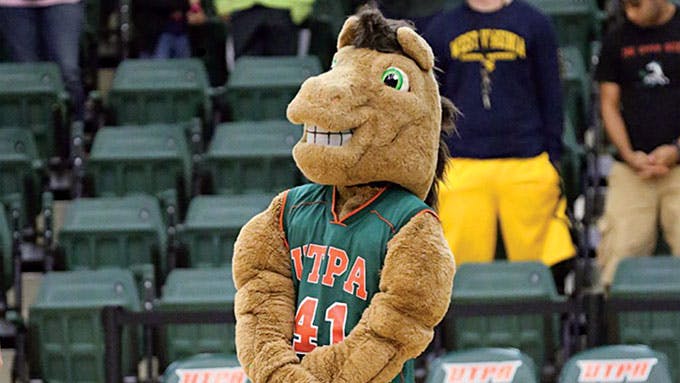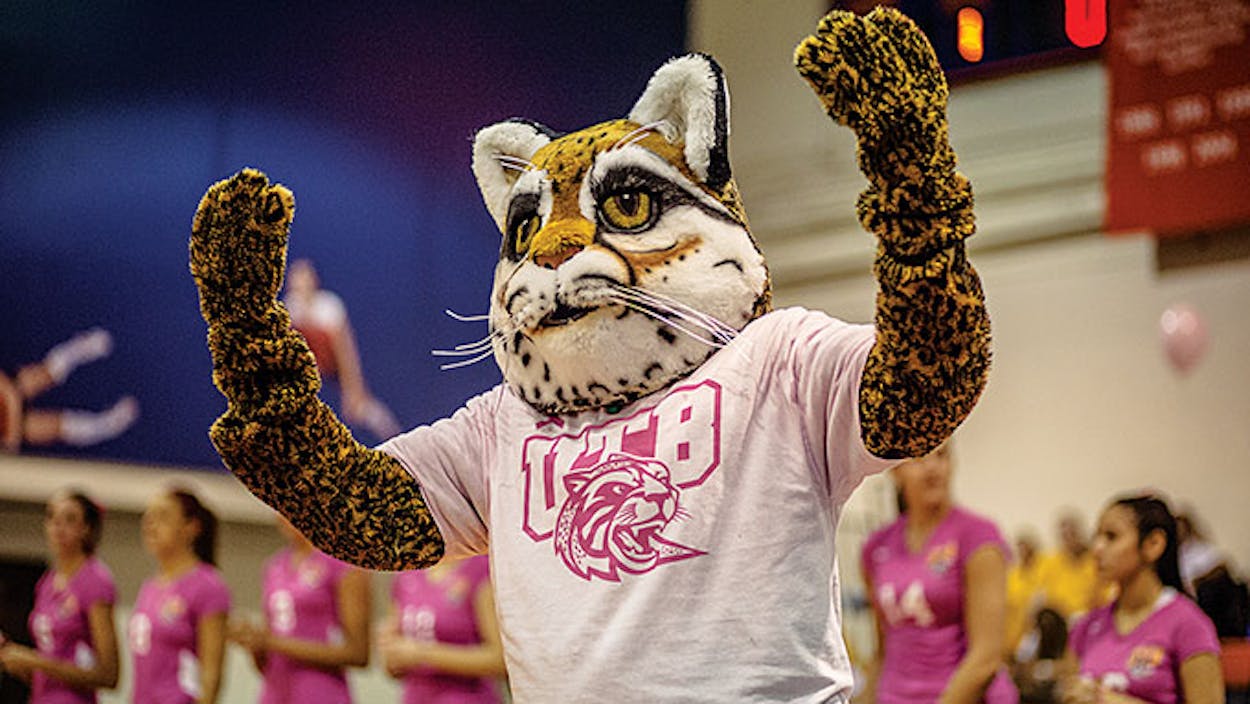
When Guy Bailey was named the sole finalist for the presidency of the University of Texas–Rio Grande Valley in April, he no doubt anticipated a few of the challenges involved in overseeing the launch of the new institution. He would be engaged in the complicated task of creating the UTRGV medical school. He would need to position the university to take advantage of the research opportunities created by the construction of the SpaceX launch center, in Brownsville. And he would have to ensure that the consolidation of the two universities that would make up UTRGV—UT–Pan American, in Edinburg, and UT-Brownsville, 65 miles southeast—went off smoothly.
One thing Bailey probably didn’t anticipate, though, is that his biggest headache would involve a six-foot-tall fuzzy horse who walks on two legs and goes by the name of Bucky the Bronc.
The ballad of Bucky the Bronc began in June 2013, when Governor Rick Perry signed Senate Bill 24, creating UTRGV. The bill’s primary intent was to establish a major new university in the Valley without having to build something from scratch. But the bill also shored up the financially troubled UTB by merging it with UTPA, which was flourishing thanks to the economic boom in the McAllen-Edinburg-Mission metropolitan area. “It will mean new doctors to treat South Texas patients, new start-ups utilizing discoveries made in the Valley, and new opportunities for all Texans across the state,” Perry said. But the plan for the new school was contentious almost immediately.
First, business and political leaders from both areas argued about where the medical school should be located, before eventually deciding to put the teaching hospital in Harlingen and the school itself in Edinburg. Then there was a protracted argument about what the school’s new name would be. In November of last year, the board of regents narrowed down the list of possibilities to five finalists: University of Texas for the Americas, UT–Las Americas, UT–Rio Grande Valley, UT-South, and UT-International.
The public outcry came quickly in Edinburg. UTPA has long been central to the city’s identity, and people were reluctant to give up their old school ties. Former state representative Roberto Gutierrez, a Democrat from McAllen, petitioned the regents to call the new school UT–Pan American. The McAllen Monitor published guest columns from UTPA students making the same argument. Officials from the UT System received plenty of entreaties along similar lines. And sure enough, when the list was narrowed down to three, UT–Rio Grande Valley and UT-South were joined by a candidate that hadn’t been among the final five: UT–Pan American.
In Brownsville, the backlash was immediate. “It shouldn’t have been on there,” says Philip Martinez, a member of UTB’s student government. “It was just a shocker. Everything should be completely new. It wouldn’t be fair.” That sentiment was widespread in town, and ultimately—and perhaps to its surprise—the Brownsville contingent carried the day. In December it was announced that the new school would be known as UT–Rio Grande Valley.
But the fight had exposed a rift, a rift that one might come to understand by simply driving to the two schools. If you approach the UTB campus from the west, you pass through downtown Brownsville, a squat collection of old, one-story buildings and businesses like Payless ShoeSource and furniture shops that offer short-term loans in the same convenient location. From the east, you pass by the Veterans International Bridge, which crosses the Rio Grande into Mexico. Brownsville is the poorest metropolitan area in America, and it looks like it.
McAllen-Edinburg-Mission is the third-poorest metropolitan area in the country, but the differences are stark. On Edinburg’s University Drive you pass by the Maki Sushi Bar, Starbucks, Chili’s, and GameStop, all a reassuring twenty miles north of the border. The median family income in Edinburg is 30 percent higher than in Brownsville. Even the names used to describe the respective regions drip with class issues: Edinburg is nestled in the “Upper Valley,” Brownsville in the “Lower Valley.” Roberto Godinez, who teaches at South Texas College, in McAllen, puts it in terms that fans of The Simpsons will understand. “There’s kind of a Springfield-Shelbyville thing going on,” he says.
So it was perhaps not a surprise that, a few months after the naming battle was settled, another fight began to brew. Last summer, a committee made up of students from UTPA and UTB met to come up with a list of potential mascots for the new school. That list included uninspired head-scratchers, like the Bears, which has already been prominently laid claim to by another Texas university; charming-but-inappropriate-for-athletics names, like the Tortoises and the Bull Snakes; and potentially controversial suggestions, like the Aztecs, which would be tough to pull off at a time when naming teams after indigenous people is extremely contentious, even in a region where many people have indigenous ancestry. Conspicuously missing from the list was UTB’s mascot, Ozzie the Ocelot, and UTPA’s Bucky the Bronc. And once again, Edinburg made itself heard.
An online petition at Change.org that launched in August by UTPA grad and Houston sports-radio personality Alex Del Barrio called on Guy Bailey and UTPA president Robert Nelson to “Save Bucky.” It quickly amassed more than three thousand signatures. Then the politicians got involved. On September 2, Edinburg city councilman J. R. Betancourt introduced and passed a pro-Bucky resolution. “The Bronc has been here since 1927. There’s so much history behind it,” he says.
Betancourt is a UTPA graduate, and so is his wife, Renee Rodriguez-Betancourt, who joined us during our interview in Edinburg’s gleaming, state-of-the-art city hall. Also sitting in was city public information director Irma Garza, another UTPA grad, and city manager Ramiro Garza Jr., a UTB grad. All four offered impassioned testimonials to Bucky’s importance. The Bronc, they noted, served as UTPA’s mascot as it evolved from Edinburg College to Edinburg Junior College, in 1933, to Pan American College, in 1952, to Pan American University, in 1971, and to the University of Texas–Pan American, in 1989. “I think it’s very important for us to save the Bronc,” J. R. said. “It’s such a part of us.”
Some of the anxiety over the changes likely stems from the fact that UTPA is seen as a school that has been on the upswing in recent years, and one whose traditions are therefore worthy of respect. “A lot of people here saw Pan Am as not their first choice,” J. R. says of the years when he was growing up. “Many of us couldn’t afford to go away. But now that’s changing.” The Betancourts have been saving for their daughters’ college educations since they were born. “We told them, ‘UT, UT’ ”—by which he means UT-Austin, the system’s flagship campus. “And one day our kid asked us, ‘Why can’t I go to Pan Am? Why can’t I be a Bronc like you guys?’ ”
UT-Brownsville’s mascot doesn’t inspire quite that same level of pride, if only because it doesn’t have as long a lineage. From 1973 to 1991 the school was known as Pan–American University at Brownsville and then UT-Pan American at Brownsville and was represented, ironically, by a bronc. Then, until 2012, the mascot was a scorpion. For the past two years UTB’s teams have been known as the Ocelots.
Ozzie the Ocelot has no particular hold on the UTB student body. None of them are arguing that the ocelot should be UTRGV’s mascot. They’re not pushing for anything. They’re pushing against the Bronc. “As a student, I would be like, ‘Great, now we’re a part of Pan Am, not this whole new university,’ ” UTB’s Martinez says. “I would feel bullied, in a way.”
Which may be why a happy resolution seems unlikely anytime soon. On October 1, UTRGV’s administration posted an online survey asking students, alumni, staff, and community members if they would prefer that “UTRGV athletics have a completely new team nickname, colors, and costumed mascot” or that “the UTRGV athletics brand image be a compromise that honors the legacies of both institutions.” At Edinburg City Hall, Betancourt suggested a compromise he thought might please everybody: keep Bucky as the mascot and adopt Brownsville’s orange-and-navy color scheme as the school’s official colors.
Angelica Corona, a member of UTB’s student government, doesn’t think this is such a great offer. “That’s just like if we asked them, ‘Let’s keep Ozzie the Ocelot as the mascot and use UTPA’s green and orange colors,’ ” she says. “It’s the same question.”









